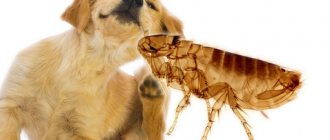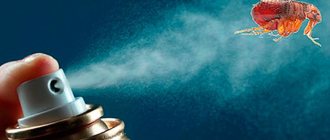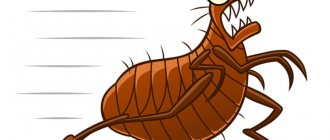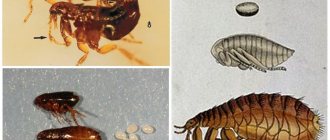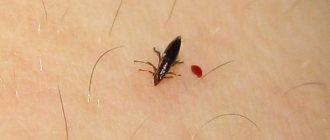Chicken fleas are parasites that live in the plumage of chickens. Despite their small size, they pose a great threat.
Birds infected with these parasites suffer from a sharp decrease in immunity, lose weight, become infected with infectious diseases and die. In some cases, chicken fleas can cause the death of the entire flock.
Description and life cycle of the chicken flea
Externally, chicken fleas are similar to blood-sucking parasites that live on cats and dogs. They are small in size and brown in color. The body of the chicken flea reaches 1.5 mm in length. On top it is covered with a hard shell, which performs a protective function.
Due to their external similarity, these parasites can easily be confused with mites, which look the same as chicken fleas. You can distinguish fleas from ticks by the way the bloodsucker moves. The tick cannot jump. It moves with the help of small limbs and is not able to quickly cover long distances.
Flea
Chicken fleas can withstand high temperatures. Even at air temperatures of 400C, these parasites continue to multiply. The female chicken flea lays a large number of eggs at a time and scatters them throughout the house using her hind legs.
Larvae that emerge from eggs most often live in the litter. Their food becomes rotten grass, chicken droppings and dried bird blood. Fleas move onto the body of chickens after going through the pupation stage. As a rule, 3-4 months pass from birth to death of a flea.
Life cycle and behavioral characteristics
Adult chicken fleas tolerate temperatures of +40 degrees. They almost always remain on the body of an infected bird.
Sexually mature females lay eggs almost daily, which they scatter around the room with their developed hind limbs.
After hatching, chicken flea larvae resemble small worms. They live in the thick bedding on the floor of the chicken coop.
The main diet of underdeveloped individuals consists of organic matter from chicken droppings; they also feed on rotten food, grass, and dry blood.
After passing through the growth stage, a morphological change occurs, then transformation into an adult and parasitism on poultry.
The lifespan of a chicken flea is up to one and a half years. The average period is 8-10 months.
Getting into the chicken coop occurs in the following ways:
- infection from wild birds that are carriers of the pest;
- spontaneous migration of microorganisms from neighboring farms or poultry farms;
- along with the bedding.
Be sure to read:
Large goiter in a chicken: what to do, causes and treatment
Due to rapid reproduction, extremely rapid spread throughout the chicken coop or farm begins.
Where do chicken fleas come from?
Chicken fleas can get into the chicken coop in several ways:
- New birds often become the cause of an infestation in a chicken coop. They can be carriers of parasites.
- Chicken fleas can enter the house along with new litter. It may contain larvae or adult parasites.
- Fleas on chickens can be detected after another walk outside the chicken coop.
- The owner can also bring parasites into the poultry house. Despite the fact that fleas rarely attack humans, they may well be used as a means of transportation. The parasite can remain on clothes or shoes after, for example, visiting someone else's chicken coop.
- Wild birds can also become a source of infection.
Attention! Chicken fleas most often live in dirty poultry houses. Old bedding, uncollected bird feed and chicken droppings create an ideal breeding ground for these parasites. It is much more difficult to survive in a clean chicken coop.
Signs of chicken flea infestation in birds
The main sign of chicken flea infestation is restless behavior and deterioration in the appearance of the birds. Due to the parasite's bites, chickens begin to itch and pull out their feathers. Another sign of fleas in the chicken coop is a decrease in egg production. In addition, the birds become less active, they begin to eat more, but despite this they lose weight.
Attention! Parasites can also be noticed after an external examination of the bird’s head. Typically, fleas infect the ridge and area around the eyes.
In young birds, fleas can cause developmental delays. In this case, weak individuals most often die.
How dangerous are flea bites for birds?
Bird fleas are carriers of many dangerous diseases. The bite of this parasite can lead to the development of:
- encephalitis;
- plague;
- salmonellosis;
- brucellosis.
Bites
Fleas pose the greatest danger to those birds that are constantly indoors. Chickens that are walked outside the poultry house have the opportunity to get rid of fleas by bathing in dust.
Prevention of chicken fleas
It is easier to prevent fleas from appearing in the house than to remove them. To do this you need:
- Maintain cleanliness in the room, then the larvae and pupae will be regularly removed from the room, even if they were there.
- Add fresh sawdust to the floor.
- Ventilate the room regularly.
- Place brooms of herbs in the chicken coop, the smell of which will repel parasites.
- Graze chickens more often. By leaving the chicken coop, they reduce the intensity of flea reproduction and can clean the feathers in anthills or dust.
Chicken fleas do not bite people, but they are carriers of dangerous diseases.
Insects can lead poultry to exhaustion if measures are not taken. The fight against chicken fleas requires careful treatment of each bird individually and the room as a whole with insecticides. To protect poultry from the pain and consequences of bites, it is important to maintain cleanliness, provide access to fresh air and use folk remedies that repel bloodsuckers.
Is there a threat to humans?
Chicken fleas cannot live on humans. Its body temperature is significantly lower than that of birds, and there is no feather or fur. All this is not suitable for the normal functioning of these parasites. They can only use a person as a means of transportation, clinging to his clothes. Thus, the owner of the chicken coop does not even suspect that he is transporting bloodsuckers on himself and becoming a source of infection.
By the way, a person himself can be attacked by fleas, although they cannot live directly on him.
How to get rid of chicken fleas?
If you notice fleas on birds, you need to act quickly. Timely measures taken will help reduce the likelihood of the spread of parasites and maintain the health of chickens.
The first and most important rule is that it is necessary to treat not only the birds, but also the poultry house itself. Eggs, flea larvae and adults may remain in the room, which will cause reinfection of the birds. In this case, the question of how to remove fleas from chickens will arise again and again. At the same time, the probability of bird death will increase significantly.
Ways to fight
The following will help get rid of parasites such as chicken fleas:
- insecticidal preparations;
- folk remedies.
Insecticides are also used to treat the premises in which infected birds live.
Drugs for fighting
The most effective drugs for controlling chicken fleas are:
- Drops Bars.
Drops are applied to the withers of the infected bird and gently rubbed into the skin. The active substance penetrates the chicken’s bloodstream. The parasite dies after biting the treated bird. This chicken treatment will rid birds not only of fleas, but also of ticks.
- Oral drug Ivermectin. A solution prepared at the rate of 0.4 ml of the drug per 1 liter of water is given to the birds 2 hours after the last feeding.
- Butox poultry treatment product. This flea treatment for chickens is available in 2 ml ampoules. To prepare a working solution, 1 ampoule of Butox must be diluted in 4 liters of water. The prepared solution must be applied to the feathers of infected birds.
Attention! Before treating chickens with flea products, it is important to take care of your own protection. If they come into contact with human mucous membranes, these drugs can cause poisoning.
Butox
When fighting chicken fleas, it is necessary to treat each individual. Group processing is ineffective.
Folk remedies
You can fight fleas in a chicken coop using both special preparations and folk remedies. Birds and the room in which they live are treated with concentrated decoctions of tansy, wormwood, and eucalyptus. The smell of these plants repels parasites.
Attention! Unfortunately, folk remedies can only scare away or make parasites go away.
Therefore, it is better to treat fleas in birds using special preparations, combining treatment with traditional recipes.
How to remove ticks from chickens
This insect is a real disaster, how to deal with them if it hides in the most secluded places of the chicken coop, where even strong solutions are out of reach.
This problem faces not only amateur poultry farmers, but also industrialists. The saddest thing is that the folk method in the form of sand baths does not help (there are no ticks on the chicken during the day, or few). At the moment, biologists are searching and no treatment has yet been developed.
Chicken mite
Folk remedies such as garlic, vinegar, yarrow, lavender, etc. (the list goes on for a long time) do not help.
You can treat the chicken coop with the drugs listed above, as well as:
- "Acromed";
- Medifox;
- "Avicin";
- "Medilis".
Expert advice
Viktor Nikolaevich Travnikov
For about 20 years he has been breeding laying hens, broilers, geese, ducks and other poultry. Our expert who is always happy to help readers.
Ask a Question
For all drugs, the main active principle is permethrin. It is this that helps to cope with the tick, since other bases are powerless.
The poultry farmer can be consoled by the fact that with the onset of cold weather, the mite goes into hibernation (it can remain hungry for 12 months). However, with the arrival of warmth, it intensifies its activity. There is information that when searching for how to deal with ticks, flypaper was used and the insect was actively sticking. But as a remedy for fleas and fluff eaters, Velcro is completely unsuitable.
A very good method is firing with lamps . However, it is only acceptable for metal structures.
As one of the methods, it can be proposed to completely empty the chicken coop of birds for a year. However, this does not guarantee that the imported young animals will be “clean”.
Statistics show that there are no longer tick-free farms. Its distribution area is so large that it becomes impossible to completely cure the population. Arachnologists are constantly searching for ways to combat this scourge.
Attention! If you are looking for an answer to the question of what to do if chickens have lice, fleas, ticks and are looking for information, do not be led by non-professionals. It is forbidden to use medications for productive animals that are intended for fleas for dogs and cats.
If the product is not intended, then the active substance passes into the blood, meat and eggs and the high-quality product turns into poison.
It is important not to use drugs (even as an experiment) if they are not intended for these purposes. For example, insecticidal smoke bombs (“City”, “Yamal”, “Quiet Evening”) work well against insects, but they “do not kill the red chicken mite”.
Don’t know what to feed laying hens to help them lay eggs better? The answer is here:
By observing the habits of the bird, looking closely and listening, you can easily determine who lives on the bird. If you do this in a timely manner, it becomes easier to deal with parasitic insects. By organizing baths, you can prevent fleas, lice eaters, and feather eaters from entering your poultry yard. Frequent cleaning, changing bedding, treating cages, nests and perches will help regulate the number of mites until they are eliminated.
Like the author!5
- Even more interesting:
- Marek's disease of chickens: description, methods of control
- Why turkey poults fall on their feet and how to deal with it
- Methods for effective control of worms in chickens
Discussion: 2 comments
- Pavlik:
12/12/2018 at 10:29Raising chickens is nothing new to me. I have been doing this for 6 years and only recently did this misfortune overtake me. At first I didn’t know how to cope with this disaster. And then I started using the tips given above and you know, they work. So far everything is quiet and there are no parasites.
Answer
- Yana:
12/15/2018 at 20:48
For me personally, raising chickens is not a new thing; I have been doing this for 5 years, and of course, during this period of time I have encountered fleas and lice on chickens. At first, of course, you are lost, because you don’t think that such a parasite can develop, but then you begin to fight and the methods described above are familiar to me. they work.
Answer
How to get rid of chicken fleas in a chicken coop?
It is impossible to completely get rid of chicken fleas by treating birds alone. Parasites will remain on the walls of the chicken coop and in the litter, which will lead to re-infestation. It can be prevented by treating the entire chicken coop for fleas.
You can treat your chicken coop for fleas:
- aqueous suspension of Karbofos;
- Delcid emulsion;
- Cucarachi emulsion;
- Deltamethrin;
- dust.
After treatment, the poultry house is closed for several days, after moving the chickens to another room. The chicken coop is processed in 2 stages. Disinfection is repeated after 14 days to destroy parasites emerging from eggs, using the same drug. 2-3 days after the second treatment, it is necessary to clean the chicken coop of droppings, replace the litter and nests.
Methods of controlling parasites
There are two ways to get rid of chicken fleas in a chicken coop. The first is based on the use of chemicals, the second - on the use of traditional therapy.
Be sure to read:
What internal and external (skin) parasites look like in chickens, symptoms and treatment
In any case, you will need to completely clean and disinfect the chicken coop. Immature fleas live in the litter, so you will need to completely clean and dispose of the litter along with the larvae.
Next, you need to treat the feather cover of chickens with various chemicals. Traditional therapy and medications against parasites can be used in combination. This approach is more effective.
Fleas in chickens: how to fight
In any case, it will be necessary to completely clean and disinfect the chicken coop.
Drugs against parasites of general or targeted action give good results.
List of drugs:
- Neostomazan - used externally, locally. The ampoule of the drug is mixed with water, then the feather cover of the chicken is treated with the solution.
- Butox . The active ingredient is the insecticide Deltamethrin. The product is highly effective against large-scale insect infestations of livestock.
- Deltamerin is a powder used as a powder.
- Inverkmectin is administered subcutaneously.
How to treat a chicken coop for lice and fleas
To remove fleas from a large chicken coop, you need to carry out large-scale treatment of the entire flock (from 20 individuals). Treatment is carried out by treating with insecticides. To do this, it is best to use dissolved preparations that are sprayed on the bird.
Powders are used individually. It is necessary to apply the medication under the feather cover of each bird, observing the required dosage.
It is undesirable to allow powdered drugs to come into contact with the mucous membranes of the eye or nose: the drug causes irritation and inflammatory processes. In the chicken coop, birds are sprayed at night when the animals are sitting on their perches.
How to treat a chicken coop for fleas:
- Ecofleece;
- Sevin;
- Deltamerin;
- Pyrethrum;
- solutions of dicresyl, trichlorometaphos, chlorophos, dibrom.
Herbs
Plant raw materials of some herbs help well against parasitic infestation. These are mainly herbs that have a pungent, pungent odor. Tansy, rosemary, and wormwood cope well with the spread of parasites.
The use of herbs is suitable as a preventive measure. In case of invasion, it is necessary to supplement treatment with another method.
Decoction
Spraying a decoction of tansy, rosemary and wormwood throughout the chicken coop is also effective. The method is best used with laying out herbs around the room. You can also spray the chickens themselves.
Ash
Stove ash helps a lot. You need to sprinkle the inside of the chicken coop with stove ash on the bedding. It is also advisable to install a large open container filled with ash to about half.
Animals will roll around in the ash bath on their own. However, if you fill it completely, the ash will constantly spill out.
Be sure to read:
The first signs of bird flu in chickens: what to do, how to treat a sick bird
Chemicals
Chemical methods are necessary for large-scale invasions. Improper use of solutions can lead to irritation of the poultry's mucous membranes and, as a result, health problems.
Chemical treatment methods will require relocating the livestock to another room and subsequent disinfection. Old litter in the chicken coop must be burned.
Butox
The medication is available in the form of a concentrated solution of insecticides. Convenient for mass processing of poultry stock. One ampoule of concentrate is dissolved in 4 liters of water.
Precautionary measures when working with Butox are quite serious. You will need to wear rubber gloves and a respirator mask to protect your respiratory tract. The easiest way is to spray the livestock with a garden sprinkler. You also need to sprinkle the powder on the floor in a thin layer.
Deltamethrin powder
Deltamethrin is also a widely used insecticide against fleas and lice. Copes with all exoparasites.
The active ingredient is a contact pesticide. Be sure to wear personal protective equipment - gloves, goggles and a protective mask. Birds are processed separately. It is not advisable to allow the powder to get into the eyes of animals.
Use of folk remedies
Chemical methods are necessary in case of large-scale invasion.
For these purposes, herbal decoctions are used and plants are laid out around the room. It is advisable to treat the walls with kerosene. Insects cannot tolerate pungent or strong odors and will avoid being in the chicken coop.
However, traditional methods are best used as preventive measures. When treating extensive infestations, they will be of little help.
Preventive actions
Getting rid of chicken fleas in a chicken coop can be quite difficult; it is much easier to prevent their appearance.
- The first thing you should pay attention to is wild animals and birds. Mice, rats and wild birds can carry fleas. To prevent infection, it is necessary to do everything possible to ensure that chickens do not come into contact with them.
- You can’t ignore the dirt in the poultry house. Old bedding, large amounts of chicken droppings and leftover bird feed will create ideal conditions for parasites to multiply.
- Inspect new birds. They can carry chicken fleas. Before placing them in a common chicken coop, you need to quarantine them and carry out preventive treatment. Any flea drops will do for this.
- To prevent contamination of the poultry house, it is recommended to place boxes with coal or wood ash in it. By bathing in the ash, chickens will clean their feathers and get rid of fleas.

